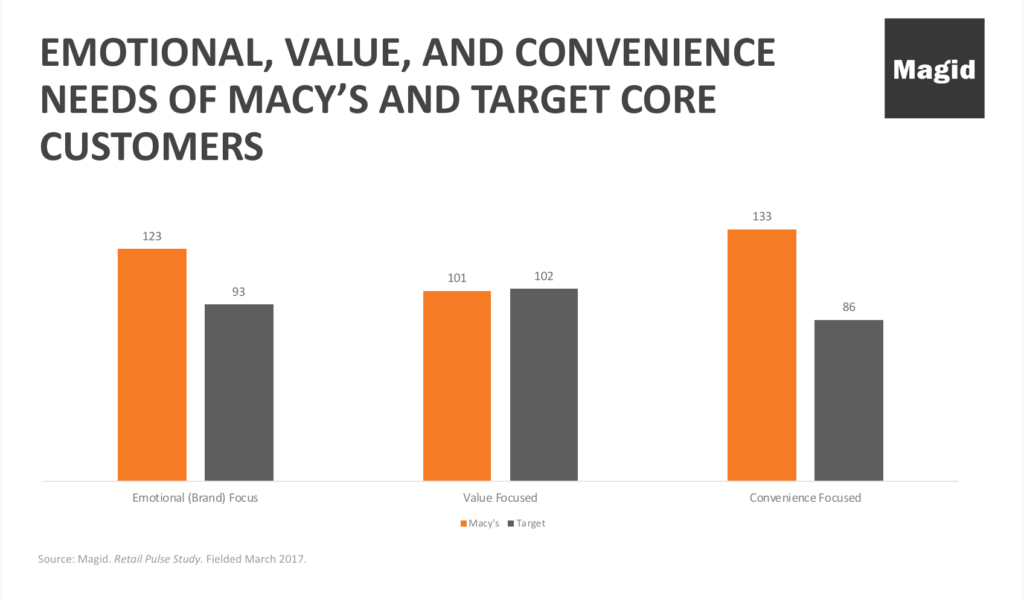Q1 Retail Earnings – Key Imperatives for Retailers
This piece is related to a segment that appeared on Bloomberg on May 23, 2018. Magid’s senior vice president of retail, Matt Sargent, spoke with Bloomberg’s Alix Steel on “Bloomberg Daybreak: Americas.”
Q1 retail financials are in full swing and while it’s easy to beat up on specific “misses” and praise outstanding “hits”, we look at the bigger plays that are creating long-term winning strategies.
4 Key Imperatives for Retailers
Relationship Shift – Retailers need to understand, and rapidly embrace, the shift from being a transactional entity (focused on efficient delivery of product) to a relationship entity (focused on various key elements of the customer experience). This is an overarching theme that is seen throughout all imperatives but is fundamental. Focusing 100% on cost reductions will only slow, not change the trajectory of troubled retailers.
Unique Customer Profile – Every customer is a snowflake which makes every retailer’s core customer set a unique entity. Understanding how the customer is unique is a fundamental first step and quickly leads to understanding how a specific strategy that works for retailer Y may not work for retailer Z.
Two examples speak to how Macy’s is optimizing its strategy in beauty to address the unique nature of the Macy’s customer. Macy’s was able to understand the unique nature of its customers and their strong emotional desire for brand connection and convenience.

The need for a stronger connection to brand is not realized through brand silos, but rather the ability to “discover” brands. Realizing this, Macy’s has announced that it is moving away from its traditional brand silos in beauty and is training advisors in all brands. This addresses consumer desire for transparency and not being boxed into a specific brand.
Macy’s is implementing AR driven YouCam Makeup magic mirror kiosks, which allows customers to try on 250 makeup items virtually. AR is having a huge impact in retail with customers that desire convenience and seek inspiration. Retailers are looking to AR to address needs within all areas, including apparel and furniture.
Value/Friction – A mapping of the relative value and friction (value = what customers love about your offering, while friction = what potentially keeps a consumer from engaging in your offering) of your offering(s) is crucial to understand how customers view you in comparison to a rapidly changing market place. Amazon has pushed the “friction” side of the question which has caused many retailers to lose perspective on the relative value of their offerings.

An understanding of how consumer attitudes are shifting around both value and friction is essential to the development of new concepts that will resonate with customers. Kohl’s has done this in its partnership with Amazon (accepting Amazon returns in test stores) with strong increases in traffic.
Emotional Profiles – Emotionally connecting with customers is a fairly obvious outgrowth of the shift to a relationship-based model of retailing. What many retailers fail to recognize is that this is perhaps the BEST way for a traditional retailer to differentiate itself in today’s world. Many retailers also struggle given the “squishy” nature of emotions and fail to realize that there are marketing disciplines that quantify emotions in ways that allow retailers to operationalize emotional drive strategies.
The battle is being won at the point of contact – physical retail – and its ability to emotionally engage with customers. An example of this is digital pure play Brandless and their recent pop up store in L.A. Despite having all the efficiencies and advantages of being 100% digital, Brandless opted to engage physically with potential customers for a two week pop up in L.A. Rather than offering to sell product at the pop up, the Brandless store focused on immersing consumers in the Brandless experience. EVERY retailer needs to pay attention to the move of digital native players (Warby Parker, Casper, Glosser, etc.) in the physical space as it represents the POWER of the physical connection and the ability of physical retail to create an EMOTIONAL connection.
The buzz around private label has been intense and the reasons are obvious. Private label is the single best way for retailers to differentiate themselves in today’s market. Succeeding in private label requires the development of a brand that emotionally connects with customers. An interesting example of this is Kohl’s recent announcement that it will be carrying a line of PopSugar apparel products focused on female millennials. PopSugar is a social media entity and Kohl’s is utilizing the emotional narrative that exists between PopSugar and its 31-million followers to “inform the assortment and drive unique joint marketing approach.” This type of “outside in” approach is a requirement of retailers looking to create a brand that won’t be tossed aside by today’s customer.
Ways Retailers and Brands can Operationalize These Imperatives
- Build an Emotional Profile – Understand your customer’s emotional (not demographic) profile and build a strategy powered by these profiles.
- Develop a Private Label that Connects – Don’t simply provide a national brand equivalent, build a brand that drives traffic and customer loyalty.
- Emotional Needs and CX – Design a store experience that speaks to emotional needs.
- Create Emotionally Connected Messaging – Don’t just create a “strong” message, utilize Magid’s Emotional DNA solution in order to quantify which message creates a “connection”.
Contact Magid to discuss how your unique customer and the strategy to turn this understanding into action.
Check out these other Magid articles:


